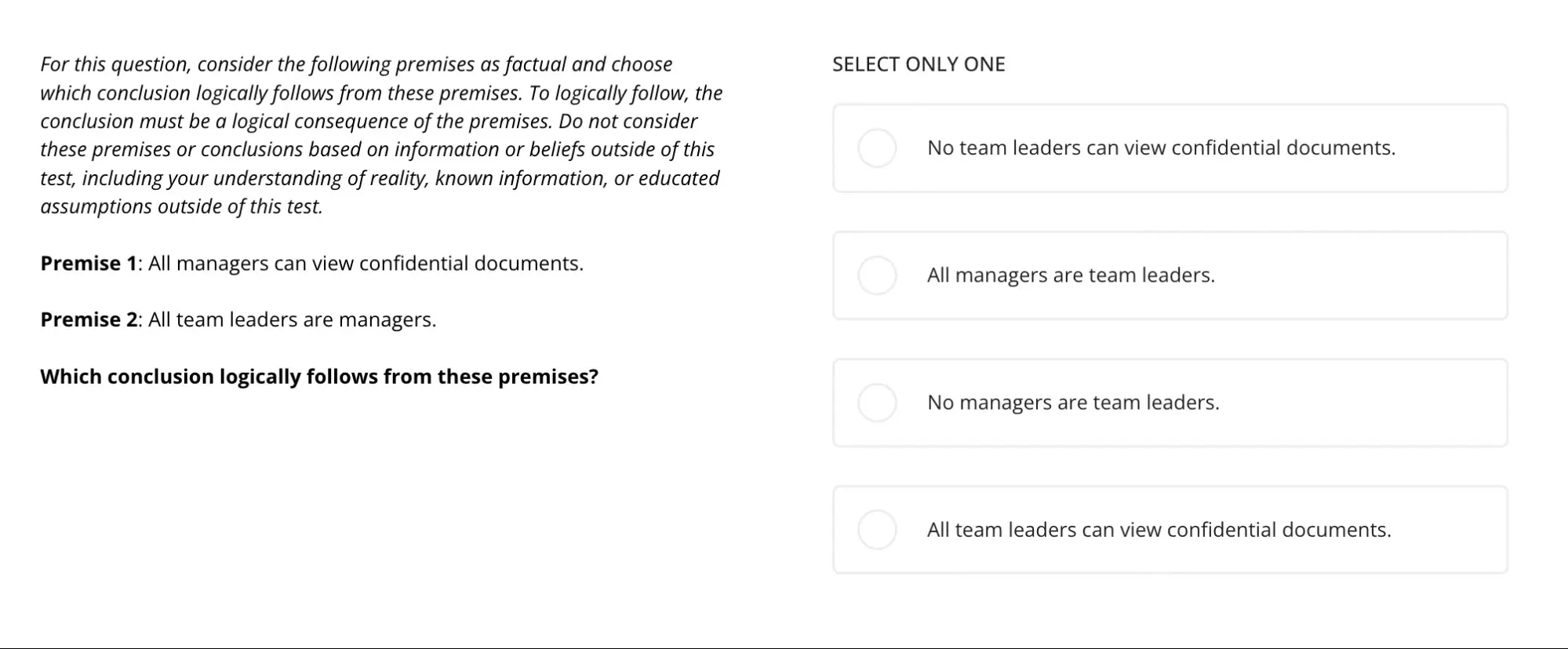Interviewing is a unique opportunity to filter applicants so that you can identify the best candidate that’s a great culture add for your company. However, when left unchecked, interviewing has downsides and risks, such as increased bias and inconsistent results.
So use this article to understand how to be a good interviewer and uncover a list of the ideal qualities of an interviewer.
By improving your interviewing skills, you can:
Make your hiring process more efficient
Minimize biases and level out the playing field
Improve consistency and comparability across candidate interviews
Make more informed, objective hiring decisions
Sound enticing? Let’s begin.
Table of contents
Why is being a good interviewer important?
Interviews are a critical part of the hiring process, whether you conduct them in person or digitally. How you conduct an interview directly impacts the results you get from it. A job interview makes a strong impression on the candidate and is a key factor in their decision of whether or not to accept a new job offer from your company.
Consider these statistics:
58% of job seekers declined a job offer due to a poor candidate experience
A negative experience with the interviewer and a slow or disorganized interviewing process are important decision-making factors for applicants
37% of job candidates leave a negative review after a single negative experience with an organization, whereas 61% leave a positive review after a positive experience
The bottom line is that being an effective interviewer can result in more successful interviews, help you make better hiring decisions, and avoid mis-hires.
The best part is you don’t have to be born a great interviewer. You can improve your approach and get better results.
The qualities of a good interviewer
So, what makes a good interviewer?
Active listening and conversational skills: Listen to a candidate’s verbal and non-verbal messages, empathize with them, and actively engage with them by asking relevant follow-up questions.
A calm, relaxed, and friendly attitude: A calm demeanor with gentle eye contact helps candidates feel comfortable, relaxed, and appreciated during the interview. This can also give them a good impression so that they want to work with your company.
An organized and methodical approach: The key to making the right call is taking strategic, organized action and not letting your emotions cloud your better judgment.
Questioning and probing skills: This involves knowing how to frame questions to get the information you want and being willing to challenge candidates – but striking a balance so you don’t come off as too confrontational or intimidating.
Decision-making and evaluation skills: This means not just focusing on the candidate’s skills and past experiences at face value but also evaluating their potential.
How to be a good interviewer: 8 practical tips
These are the bare minimum requirements for any interviewer:
Being on time
Maintaining a positive atmosphere
Keeping the process as straightforward and efficient as possible
Communicating with the candidates
Once you have these down, you should move on to perfecting our eight proven tips and using them to hire better candidates and build a stronger talent pool for the future.
How to be a good interviewer: A summary
How to be a good interviewer | Key points |
Understand the job requirements and responsibilities | - Have a clear understanding of the role so you can more accurately assess candidates - Demonstrate you’re knowledgeable about the role |
Prepare structured interview questions based on the role | - Create a tailored list of questions to ask each candidate to make it easier to compare them - Ask skill-based questions |
Create a comfortable environment for the candidate | - Eliminate ambiguity - Maintain a relaxed and friendly demeanor |
Use active listening and ask follow-up questions | - Listen 80% of the time and talk 20% - Be an active listener – ask follow-up questions and give feedback |
Evaluate responses based on predefined, standardized criteria | - Know your criteria ahead of time - Have a colleague you trust interview with you to help you stay objective and reduce personal bias |
Take opportunities to challenge the candidate respectfully | - Ask open-ended questions to see how candidates think and perform under pressure - Respectfully challenge answers to gain insights into how they react to constructive criticism |
Give the candidate an opportunity to ask questions | - Gain insights into what’s important to the candidate and how they think - Ask for feedback to improve your hiring process |
Communication clearly about the hiring process and follow-up | - Make sure the candidate knows how many stages your hiring process has - Give a time estimate for when they can expect to receive a yes/no |
1. Understand the job requirements and responsibilities
Too many hiring managers conduct interviews without having a clear understanding of the role and what it entails. This makes it more difficult to accurately assess candidates and pinpoint the most important characteristics.
It’s better for all parties when the interviewer asks questions that are relevant to the role and draws parallels to the position they’re filling instead of having a one-size-fits-all mold or asking about irrelevant details.
Being unknowledgeable can be a huge turnoff for candidates. Not only does it make you seem uninvested in the interview, but it can also make the candidate feel overqualified and more likely to reject an offer later on.
We’re not saying you need to know all the ins and outs of the job, but to gain better insights and show respect for your candidate’s time, it’s important to review the job description and research the responsibilities before going into an interview.
2. Prepare structured interview questions based on the role
A structured interview involves preparing a standard set of questions you ask each candidate in the same order to make evaluating and comparing them easier.
Having a meticulous order of business is important to streamline your hiring process, reduce bias, and make sure you’re left with useful data by the end of the interview.
It’s great when conversation flows naturally. However, nothing should get in the way of learning crucial information about your candidates. Otherwise, you might end up with an incomplete picture and have a difficult time deciding who to hire.
So, use the following interview techniques:
Prepare relevant questions (looking at interview question examples for specific roles can be useful here)
Be comfortable with silence, and don’t be afraid to interrupt during the interview
Know your deal breakers and make sure you go through them in the right order with all the candidates
3. Create a comfortable environment for the candidate
Interviews are nerve-racking by default.
You can make them easier on candidates from the get-go by communicating clearly before, during, and after the interview.
Tell your applicants what to expect, including:
What the hiring process entails
The dress code and location (if it’s in person)
Who else will attend their interview
What the role, the company policies, and their work life will look like if they’re hired
When and how you’ll contact them
The next steps
These answers help candidates prepare better, leading to a more fruitful interview. But creating a comfortable environment for candidates isn’t just about clear communication.
Be friendly and let the conversation flow as naturally as the interview structure allows.
A little bit of small talk and relating on a personal level go a long way. Reassure the interviewee, tell them a bit about your day, or make a pop culture reference – anything to break the ice and help them relax.
If possible, conduct the interview in a room that’s warm and inviting. When the candidate arrives, offer them a snack or beverage.
If the candidate feels comfortable, they can show you their real selves. This helps you avoid hiring the wrong person based on an inaccurate impression or missing out on a great applicant because they were under unnecessary pressure during the interview.
4. Use active listening and ask follow-up questions
Use the 80-20 rule: Listen 80% of the time and talk 20%. Why?
If you take up too much space, you may miss out on opportunities to learn more about the candidate because:
The candidate has less time and opportunity to talk
Their answers might change based on their impression of you
You have less time to observe them because you’re busy talking
Instead, prod candidates to talk and focus on active listening over passive listening.
Passive listening can cause you to miss out on prime opportunities to learn more about candidates through follow-up questions and even more subtle cues like body language.
Active listening means listening to understand by being attentive to a person’s verbal and non-verbal messages, empathizing with them, asking relevant follow-up questions, and providing meaningful feedback. It helps you understand your candidates beyond just their answers.
Note what they say and how they speak: Are they passionate about the topic? Do they have a lot of opinions on it? Are they reserved?
5. Evaluate responses based on predefined, standardized criteria
Sticking to a standardized scale helps you rate and compare candidates’ answers and make the best hire fairly, so come up with an objective metric for each question.
Distinguish between your must-haves and nice-to-haves, and determine how you’ll measure them. Keep those measurements on a handy scorecard.
You can also team up with a colleague to ensure you stay on the right track and don’t let unconscious bias or first impressions take the wheel.
This gives you another perspective, and you can compare notes so that you know you’re being consistent and never lose sight of the most important criteria.
6. Take opportunities to challenge the candidate respectfully
Challenging candidates means finding opportunities throughout the interview to probe them to expand on or defend their answers.
For example, a candidate who can’t further explain an answer they’ve given may not be as knowledgeable on a subject as you initially believed – they may have anticipated that question and memorized the answer without the necessary critical thinking.
But this can be a double-edged sword. If you don’t have a solid understanding of a role, challenging a candidate on a technical question can backfire by making you appear unqualified, another reason to do your research on the role beforehand.
Seeing how a candidate approaches questions like these can give you insight into how they think, what they care about, and how they might mesh with their potential team members.
The point isn’t to trip candidates up – it’s to see how they perform under pressure and, in some cases, how they react to constructive criticism.
7. Give the candidate an opportunity to ask questions
The candidates are interviewing you as much as you are interviewing them. Encourage their questions.
You might learn more about what applicants look for when choosing a company and can use what you’ve learned to become a more attractive employer.
Something else you learn – which is perhaps even more valuable – is direct insight into how the candidate thinks.
For example, questions about company culture or your personal experience within the organization demonstrate a level of curiosity and a desire to be with a company that’s a cultural fit for them.
If a candidate asks questions to clarify certain aspects or responsibilities of the role, it shows a willingness to reach out to others for help when they need it, even if it puts them in a vulnerable position.
At this point, you can also address any hesitation on the candidate’s end and convince them that your organization would be a good fit for them.
8. Communicate clearly about the hiring process and follow-up
As many as 60% of candidates are ghosted after interviews – leaving them wondering if the hiring process is just slow or if they didn’t make the cut.
This is why it’s so important to make candidates aware of the next stages of your hiring process. Let them know:
How many phases of interviews your hiring process has
How long it takes to receive a decision
How you’ll reach out to them about moving to the next stage or rejection
Not only is it the respectful thing to do, but communicating clearly about your hiring process can also improve the candidate’s overall perception of your company – making them more likely to accept an offer if they do receive one.
Quality candidates make or break an interview (alongside the interviewer)
For good interviewers to be effective, they need to have a quality pool of candidates to start with. Hiring managers are often overloaded with candidate resumes and cover letters, and interviewing everyone who might be a good fit isn’t a good use of resources.
This is where talent assessments come in to help you narrow down large candidate pools to only the best and most qualified.
An example question from our Critical Thinking test, ideal for identifying candidates who can evaluate information and make sound judgments before interviews.
TestGorilla has a library of 400+ skills tests you can use to create a shortlist of candidates with a proven skill set aligned with the role requirements. Doing this before the interview stage saves you time and gives you the resources to invest in a more comprehensive structured interview process.
Ready to shortlist the best candidates for your interviews with TestGorilla? Sign up for your free forever plan today!
The next step: Get ready to interview your next candidate
Having good interview skills is essential if you’re trying to build an attractive employer brand, improve your candidate experience, and increase your hiring efficiency.
However, learning how to be a good interviewer takes some planning and practice. You’re on the right track to get there.
So, what’s the next logical step? Plan and conduct your interviews.
Here are some pointers before you start:
Define your role requirements and prepare role-specific questions
Use appropriate tests (like our Customer Service or Problem Solving test) to help you qualify candidates with the right hard and soft skills
Do your homework on applicants and leave enough time between interviews to go over your notes
Practice active listening to better engage with your candidates
Communicate clearly with candidates to manage expectations and stress levels
If you want to set yourself up for success during the interview stage, consider skills-based hiring with TestGorilla’s test library. Schedule a live demo with our friendly specialists or get started with our free forever plan to start creating a shortlist of qualified candidates today.
How to be the best interviewer FAQs
Have more questions on how to be a better interviewer? Find out more in the FAQs below.
What are the qualities of a good interviewer?
Active listening and conversational skills
A calm, relaxed, and friendly attitude
An organized and methodical approach
Questioning and probing skills
Decision-making and evaluation skills
How do you become a good interviewer?
Take the time to review the job description and the candidate’s information beforehand.
Prepare structured interview questions that are tailored to the role/candidate.
Listen actively and treat the interview like a conversation.
Evaluate your candidates fairly based on a standard set of criteria.
What are 3 tips for a successful interview?
Have a basic understanding of the role and prepare questions tailored to it.
Actively listen to ask relevant follow-up questions for more insights.
Treat the interview like a conversation and encourage the candidate to ask questions as well.
What skills do interviewers need?
Active listening
Conversational skills
Communication
Emotional intelligence
Time management
Job knowledge
How should an interviewer start an interview?
You should start an interview by greeting the candidate and offering a snack or beverage to help them feel comfortable. Then, if it’s your style, make a bit of small talk just to lighten the mood and get to know the candidate a little better. Before you begin asking the candidate questions, explain what your company does and what your role is.
Related posts
Hire the best candidates with TestGorilla
Create pre-employment assessments in minutes to screen candidates, save time, and hire the best talent.
Latest posts
The best advice in pre-employment testing, in your inbox.
No spam. Unsubscribe at any time.

Hire the best. No bias. No stress.
Our screening tests identify the best candidates and make your hiring decisions faster, easier, and bias-free.
Free resources
This checklist covers key features you should look for when choosing a skills testing platform
This resource will help you develop an onboarding checklist for new hires.
How to assess your candidates' attention to detail.
Learn how to get human resources certified through HRCI or SHRM.
Learn how you can improve the level of talent at your company.
Learn how CapitalT reduced hiring bias with online skills assessments.
Learn how to make the resume process more efficient and more effective.
Improve your hiring strategy with these 7 critical recruitment metrics.
Learn how Sukhi decreased time spent reviewing resumes by 83%!
Hire more efficiently with these hacks that 99% of recruiters aren't using.
Make a business case for diversity and inclusion initiatives with this data.


















